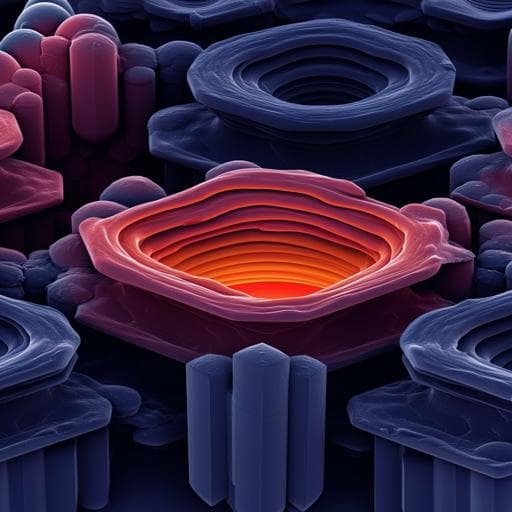
Physics
Full phonon dispersion along the stacking direction in nanoscale van der Waals materials by picosecond acoustics
S. Lee, S. Bae, et al.
Explore a groundbreaking technique for mapping the phonon dispersion in nanoscale van der Waals materials! This research by Seong-Yeon Lee and colleagues utilizes picosecond acoustics to unveil insights into the strain dynamics of hexagonal boron nitride and black phosphorus. Delve into the acoustic echoes that reveal the secrets of phonon behavior.
~3 min • Beginner • English
Introduction
The study addresses how to measure phonon dispersion, particularly along the stacking (out-of-plane) direction, in nanoscale van der Waals (vdW) materials where traditional inelastic neutron or X-ray scattering methods are impractical due to small scattering cross sections and the need for large facilities. Prior picosecond acoustic techniques can probe transverse acoustic waves at GHz frequencies but are limited by optical diffraction and frequency range. The authors propose generating broadband coherent acoustic phonons within a few-layer black phosphorus (BP) layer and tracking their propagation and echoes in adjacent hexagonal boron nitride (hBN) layers. By analyzing frequency-dependent time-of-flight of echoes and group velocity dispersion (GVD), they aim to extract the full out-of-plane longitudinal acoustic (LA) phonon dispersion in nanoscale vdW heterostructures. This approach leverages the high interfacial quality of vdW stacks and uses BP as a sensitive optoelectronic transducer, enabling access to THz-frequency lattice dynamics and providing a nondestructive probe of nanoscale structures.
Literature Review
Bulk phonon dispersion is conventionally measured by inelastic neutron or X-ray scattering, which require large-scale facilities and are not well-suited to nanoscale crystals. Picosecond acoustics has been used to probe photoexcited strain waves and interfaces in thin films, with surface-propagating transverse acoustic waves observed at GHz frequencies, limited by optical diffraction. Nanoscale generation regions, such as thin metal films, produce broadband acoustic pulses that broaden in dispersive media—an effect that can be exploited to study frequency-dependent lattice behavior. Two-dimensional vdW materials (graphene, TMDs, BN, BP) have demonstrated coherent optical and acoustic phonon dynamics, and atomically thin layers allow access to large-momentum phonons due to quantization along the thickness. The present work builds on these advances by using a vdW heterostructure to form a phonon cavity and leveraging broadband strain pulses to extract the frequency-resolved TOF and GVD in hBN.
Methodology
- Sample preparation: Two vdW heterostructures were fabricated by sequential Gel-Pak dry transfer of b-hBN/BP/t-hBN onto quartz in an argon glovebox (O2/H2O < 0.5 ppm). Thicknesses: sample A (t-hBN/BP/b-hBN) = 12 nm/1.3 nm/30 nm; sample B = 29 nm/2.3 nm/27 nm. hBN thickness from thin-film interference; BP thickness from AFM.
- Pump-probe experiment: A 1 MHz cavity-pumped Ti:sapphire laser (760 nm center wavelength, 60 fs pulses) provided pump and probe beams. hBN is transparent at 760 nm; BP absorbs, enabling selective excitation and detection in BP. Polarizations aligned with BP armchair axis. Focusing with 20× objective to a ~5 μm spot; pulse energies ~1 nJ (pump) and ~0.5 nJ (probe). Time delay scanned at 13 Hz; differential transmission ΔT/T recorded. The probe energy is resonant with BP transitions but not with hBN, so echoes are detected when the strain pulse re-enters BP.
- Signal processing and spectral-temporal analysis: Exponential/slow backgrounds removed to isolate coherent acoustic response. Sliding window Fourier transform (SWFT) with a 1.8 ps Gaussian window was used to obtain frequency-resolved arrival times and TOF. Fourier transform spectra used to identify phonon frequency combs in the phonon cavity (t-hBN).
- Physical picture: Pump generates a photoacoustic strain pulse in BP via inhomogeneous absorption (760 nm), which launches an out-of-plane LA wave into adjacent hBN. The wave reflects at the t-hBN/air interface (large impedance mismatch, flat surface), producing echoes that traverse back to BP; waves into b-hBN largely transmit into quartz or scatter at rough SiO2.
- Linear chain model (LCM): hBN layers modeled as a 1D mass-spring chain for out-of-plane LA mode with dispersion ω(q) = ω0 sin(q/2c) and group velocity v(q) = v0 cos(q/2c); c = 3.33 Å; v0 = ω0/(2c), taken as 3.44 km/s from literature. Echo time T = 2d/v with effective cavity length d including finite BP thickness. LCM used to predict frequency-dependent arrival times and GVD, compared to experiment.
- First-principles calculations: DFT (VASP) with optB86b-vdW functional used for electronic structure and phonons of bulk hBN, few-layer BP, and stacked hBN/BP/hBN; phonon properties via phonopy. LDA and optB86b-vdW GVD compared; LDA best matched LCM for GVD, while optB86b-vdW also showed good agreement (LDA underestimates band gaps but used for GVD benchmarking). A finite 6L-hBN/4L-BP/6L-hBN slab was used to analyze band structure (direct gap at Γ) and charge distributions.
- Photoinduced strain calculation: Delta self-consistent field (ΔSCF/ASCF) with occupation constraints at Γ imposed a photoexcited carrier density of 6.36 × 10^12 cm−2. Plane-averaged charge densities showed inhomogeneous VBM depletion in inner BP layers, leading to sub-ps lattice relaxation and strain that launches an acoustic pulse into hBN.
- Machine-learned force field (MLFF) and MD: An MLFF was trained on-the-fly using DFT for bulk hBN (4×4×4) and 6L-hBN/4L-BP/6L-hBN, with Gaussian approximation potential descriptors (radial cutoff 5 Å, angular cutoff 8 Å; ionic force weight 1000). MD used for real-time photoacoustic propagation after initializing the ASCF-induced strain. On-the-fly MLFF MD integrated trajectories (reported time step 0.5 ps, total 50 ps, 100,000 steps) with absorbing boundary at bottom hBN. Atomic displacements convolved with a 1 Å Lorentzian for visualization; vibrational power spectra obtained via DynaPhoPy.
- Frequency-comb analysis: In the phonon cavity (t-hBN), multiple echoes create spectral combs with mode frequencies fm satisfying m/fm = 2d/vg. Group velocity extracted as vg = Δf × 2d, where Δf = fm+1 − fm equals the inverse of the round-trip time.
Key Findings
- Broadband coherent acoustic phonons spanning 0–3 THz were generated in BP and propagated into hBN, enabling frequency-resolved TOF measurements and determination of out-of-plane LA phonon GVD in hBN.
- Echoes observed in ΔT/T correspond to round trips in t-hBN and are detected upon the strain pulse traversing BP. For sample A (12 nm t-hBN), first and second echoes appear within 50 ps; for sample B (29 nm t-hBN), distinct multiple echoes form a phonon frequency comb.
- Frequency dependence: SWFT shows strong dispersion; the TOF at 1.5 THz is 9.2 ps, approximately 2 ps shorter than at 2.2 THz, demonstrating frequency-dependent group velocities.
- LCM predictions (frequency-dependent arrival times for 1–3 round trips) match the experimental SWFT maps closely, validating the mass-spring chain model for out-of-plane LA phonons in hBN. DFT phonon dispersions (LDA and optB86b-vdW) corroborate the LCM, with LDA giving the closest GVD match.
- From λ = v/f, at f = 3 THz with v ≈ 2 km/s, λ ≈ 0.7 nm, implying feasibility of TOF measurements for few-nm hBN layers.
- Phonon frequency combs (sample B, 29 nm t-hBN) arise from interference of echoes in the cavity; two comb families reflect multiple round trips with decreasing amplitudes. The slope of fm vs m decreases with frequency, yielding smaller Δf at higher f. Group velocities derived from Δf using d = 28.6 nm agree with LCM GVD.
- First-principles origin: ASCF shows photoexcited carrier redistribution in BP induces immediate lattice strain, launching the acoustic pulse. MLFF-based MD simulations reproduce strain propagation, splitting into faster (lower-k) and slower (higher-k) packets due to GVD, and agree quantitatively with experimental ΔT/T oscillations and first echo timing for both samples.
- Echo timing scales linearly with t-hBN thickness: first echo at 7.8 ps (12 nm) and 17.0 ps (29 nm), supporting use as a nondestructive thickness/structure probe in vdW heterostructures.
Discussion
The work demonstrates that picosecond acoustics with a nanoscale BP transducer can access the full out-of-plane LA phonon dispersion in hBN by analyzing frequency-resolved TOF and spectral combs from multiple echoes in a vdW heterostructure. The frequency dependence of echo arrival times directly yields the group velocity dispersion, which is consistent with a linear chain description and DFT benchmarks. The selective optical sensitivity to BP allows detection of echoes without interference from hBN optical absorption, enabling precise timing. First-principles calculations provide a microscopic mechanism: photoexcited carriers in BP produce rapid lattice strain that couples efficiently into hBN along the stacking direction, with the subsequent propagation and reflection accurately captured by MLFF-based MD. The agreement across experiment, LCM, and DFT underscores the reliability of the extracted dispersion. The method offers a nondestructive route to probe hidden interfaces, layer thicknesses, and lattice dynamics in nanoscale vdW heterostructures and analogous thin-film systems.
Conclusion
This study establishes a picosecond-acoustics-based technique to measure the full out-of-plane LA phonon dispersion in nanoscale vdW materials. By generating broadband strain pulses in BP and tracking their frequency-resolved echoes in hBN, the authors extract group velocity dispersion up to 3 THz, validated by a linear chain model and DFT. Spectral phonon combs from a t-hBN cavity provide an alternative route to vg via mode spacing. First-principles calculations reveal the electronic origin of the initial strain and reproduce real-time propagation via MLFF MD. The approach functions as a nondestructive probe of nanoscale structure and interfaces, and is extendable to other vdW stacks and semiconductor quantum wells. Future work could generalize to different materials, polarizations, and modes (including optical phonons), optimize cavity designs for enhanced sensitivity, and integrate with spatial mapping to image phonon transport at the nanoscale.
Limitations
- Signal decay over time due to energy loss into the quartz substrate and phonon scattering at heterointerfaces reduces echo amplitudes.
- Waves entering b-hBN largely transmit into or scatter at the substrate, contributing minimally compared to reflections at the t-hBN/air interface; thus, cavity behavior relies on a high-quality, flat air interface.
- Experimental spectral window was up to ~3 THz; higher-frequency behavior was not probed.
- DFT functional trade-offs: LDA best matched GVD but underestimates band gaps; optB86b-vdW provided reliable electronic structures and reasonable GVD agreement. For simulation stability, 4L-BP was used instead of 6L-BP in one case to avoid spurious gap closing.
- Reported MD integration parameters (time steps) may limit resolution and could reflect practical or typographical constraints; absorbing boundary conditions were applied, which may affect long-time dynamics.
Related Publications
Explore these studies to deepen your understanding of the subject.







